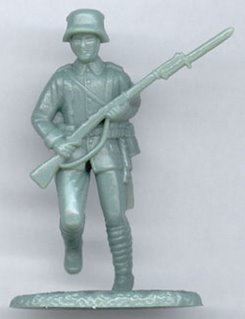

 Wargaming can be expensive - it has been estimated that a Games Workshop army big enough for a battle costs around three hundred quid and that is before you start buying terrain. And who has a table big enough? Disenchanted with the hobby I once gave my collection of tanks and figures to my then young son to play with - he and the neighbouring kids had a great time, better than I could have had, playing war with them in the dirt and among the rocks - and they brought them back pretty much intact, and then it dawned on me...why try and fight on a table when you have a garden? Wasn't HG Wells' Little Wars - the book that started wargames in 1913 ('A Game for Boys from twelve years of age to one hundred and fifty and for that more intelligent sort of girl who likes boys' games and books') all about doing it in the garden? (Read it online)
Now if that fills you with horror at putting your precious figures outside then maybe you shouldn't use them; maybe you should buy a load of 1/72 or if you have a large garden 1/32 plastics, give them a rudimentary paintjob, base them on washers for stability and use those instead. Wargaming the Great War in the garden means you can excavate trenches, dig out shell craters, and have unlimited space within reason. You can have enough room to use long range artillery fire, spotters, actually destroy trenches and troop build ups with some realism. Having cheap and cheerful armies means not spending your life modelling and instead getting outside on a sunny afternoon instead of hunched over a smokey table. Probably the easiest way is for the host to have a defensive position and the guest attack it - but be prepared for the occasional earwig or ants invasion. Whether you use normal wargames rules or ones that involve projectiles like corks to replicate howitzer fire is up to you.
Wargaming can be expensive - it has been estimated that a Games Workshop army big enough for a battle costs around three hundred quid and that is before you start buying terrain. And who has a table big enough? Disenchanted with the hobby I once gave my collection of tanks and figures to my then young son to play with - he and the neighbouring kids had a great time, better than I could have had, playing war with them in the dirt and among the rocks - and they brought them back pretty much intact, and then it dawned on me...why try and fight on a table when you have a garden? Wasn't HG Wells' Little Wars - the book that started wargames in 1913 ('A Game for Boys from twelve years of age to one hundred and fifty and for that more intelligent sort of girl who likes boys' games and books') all about doing it in the garden? (Read it online)
Now if that fills you with horror at putting your precious figures outside then maybe you shouldn't use them; maybe you should buy a load of 1/72 or if you have a large garden 1/32 plastics, give them a rudimentary paintjob, base them on washers for stability and use those instead. Wargaming the Great War in the garden means you can excavate trenches, dig out shell craters, and have unlimited space within reason. You can have enough room to use long range artillery fire, spotters, actually destroy trenches and troop build ups with some realism. Having cheap and cheerful armies means not spending your life modelling and instead getting outside on a sunny afternoon instead of hunched over a smokey table. Probably the easiest way is for the host to have a defensive position and the guest attack it - but be prepared for the occasional earwig or ants invasion. Whether you use normal wargames rules or ones that involve projectiles like corks to replicate howitzer fire is up to you.

No comments:
Post a Comment